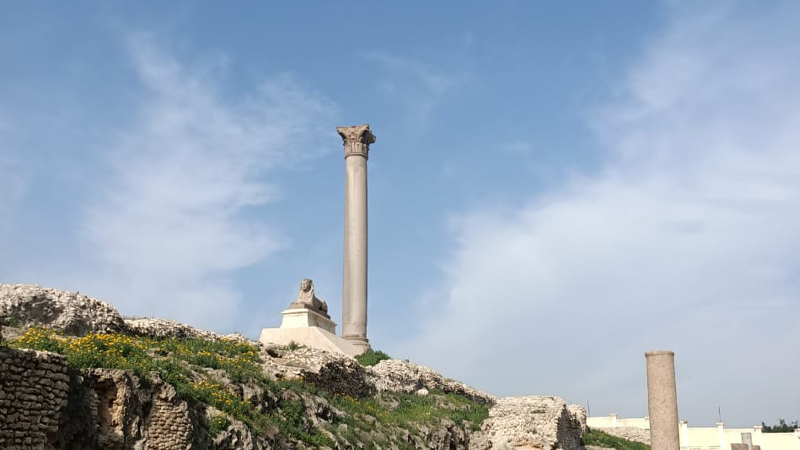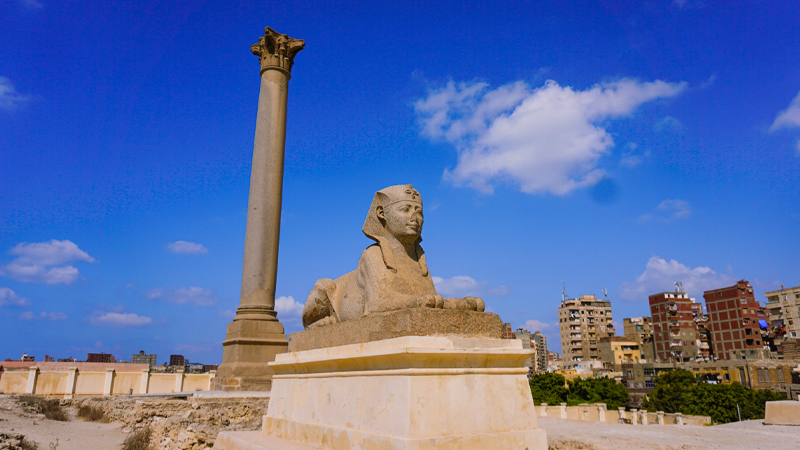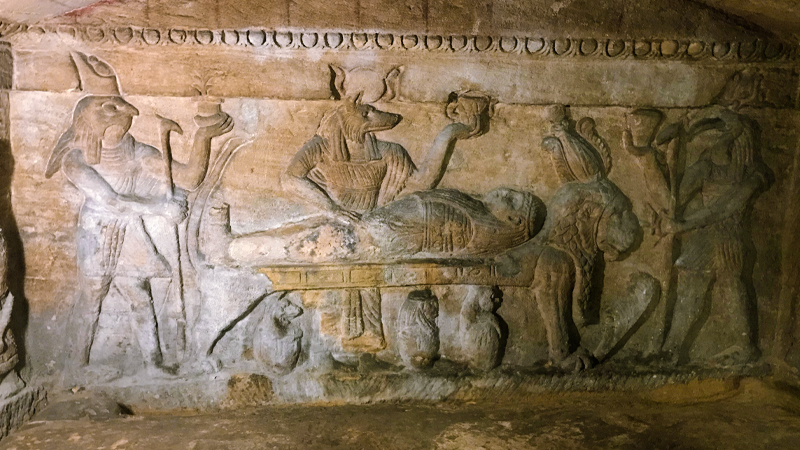Welcome to an intriguing journey through time and history as we explore the enigmatic wonder of “Pompey Pillar” in Alexandria. This majestic monument has stood tall for centuries, bearing witness to numerous events and captivating the hearts of visitors with its grandeur and mysteries. In this article, we will delve deep into its origins, the legends surrounding it, its architectural magnificence, and its cultural impact.
Pompeys Pillar
Pompey’s Pillar is an ancient landmark Roman triumphal column in the heart of Alexandria, Egypt.. This colossal structure stands at an astonishing height of approximately 25 meters (82 feet) and boasts a diameter of 2.7 meters (9 feet). Carved from a single piece of red Aswan granite, the pillar’s exquisite craftsmanship and remarkable preservation have amazed historians and archaeologists for generations.
The Origins of Pompey Pillar
The pillar’s name can be misleading, as it has no direct connection to the renowned Roman general, Gnaeus Pompeius Magnus (Pompey). It is widely believed that the true purpose of the column was to honor Diocletian, a Roman emperor who reigned during the late 3rd and early 4th centuries AD. It was erected in memory of Diocletian’s victory over an Alexandrian revolt in 297 AD.
Unraveling the Architecture
Pompey’s Pillar stands as a testament to the architectural brilliance of the ancient world. The monolithic column is a prime example of Roman triumphal columns, reflecting the grandeur of their military achievements. The shaft’s design blends Roman and Greek elements, featuring a Corinthian-style capital with intricately carved acanthus leaves.

Legends and Mysteries
Over the centuries, several legends have shrouded Pompey’s Pillar, adding to its allure and enigma. One of the most famous tales suggests that the pillar marks the burial site of Gnaeus Pompeius Magnus, whose ashes were brought to Alexandria after his assassination in 48 BC. However, historians have widely discredited this theory, attributing the legend to a romanticized imagination.
Cultural Significance
Pompey’s Pillar holds immense cultural importance, symbolizing the ancient connection between the Roman and Egyptian civilizations. It is a testament to the rich history and cultural exchange that flourished during the Greco-Roman period. Today, the pillar is a cherished heritage site, drawing visitors worldwide eager to unravel past mysteries.
The Serapeum: A Glimpse into the Past

The area surrounding Pompey’s Pillar was once part of the ancient Serapeum, a grand temple dedicated to the god Serapis. Though the temple is now in ruins, it once stood as a magnificent center of knowledge and learning during the Ptolemaic dynasty. The Serapeum was renowned for its vast library, second to the famous Library of Alexandria.
The Sphinx of Alexandria
While visiting Pompey’s Pillar, one cannot miss the nearby Sphinx of Alexandria. Carved from the same red Aswan granite as the pillar, this colossal statue represents a mythical creature with a human head and a lion’s body. The Sphinx adds an extra layer of allure to the historical site, inviting visitors to ponder its ancient significance.
Discovering the Catacombs of Kom El Shoqafa
Located just a short distance from Pompey’s Pillar lies one of Egypt’s most intriguing and unique burial sites, the Catacombs of Kom El Shoqafa. This cemetery represents a blend of Egyptian, Roman, and Greek architectural styles and offers an incredible glimpse into the cultural melting pot of Alexandria’s ancient past.

Excavations and Preservation Efforts
Over the years, numerous archaeological expeditions have unearthed invaluable artifacts and inscriptions around Pompey Pillar and its surrounding areas. These excavations have shed light on the site’s historical context and architectural splendor. Additionally, various preservation efforts have been undertaken to ensure the longevity of this ancient marvel for future generations.
Visiting Pompey Pillar: Practical Information
For those eager to explore the wonders of Pompey Pillar, the site is open to the public year-round. Guided tours are available to provide insightful narratives about the monument’s history and significance. Additionally, visitors can immerse themselves in the rich cultural heritage of Alexandria by exploring nearby museums and historical sites.
Preserving Our Cultural Heritage
Preserving historical monuments like Pompey Pillar is essential to retain the cultural identity of our civilization. By safeguarding these ancient marvels, we can pass down the legacy of the past to future generations, fostering a deeper understanding and appreciation of our shared history.
FAQs about Pompey Pillar
Is Pompey Pillar the tallest ancient pillar in the world?
While Pompey Pillar is an impressive structure, it is not the tallest ancient pillar. That distinction belongs to the Trajan’s Column in Rome, which stands at a towering height of about 30 meters (98 feet).
Are there any inscriptions on Pompey Pillar?
Yes, Pompey Pillar features a fascinating inscription in Greek at its base. The inscription commemorates the victory of Diocletian over the Alexandrian revolt and dedicates the pillar to the emperor.
Can visitors climb to the top of Pompey Pillar?
Visitors cannot climb the pillar for safety and to preserve the monument’s integrity.
What are the nearby attractions to visit along with Pompey’s Pillar?
From the nearby Sphinx of Alexandria and the Catacombs of Kom El Shoqafa, visitors can explore the Bibliotheca Alexandrina, the Citadel of Qaitbay, and the Montaza Palace.
Is there an entrance fee to visit Pompey Pillar?
Access to the site is a nominal entrance fee, and the revenue generated helps support the maintenance and conservation efforts.
Can I take photographs at Pompey Pillar?
Yes, photography is allowed at the site. Capturing the magnificence of the pillar and its surroundings is a popular activity among visitors.
Conclusion
As we conclude our journey through the history and wonders of Pompey’s Pillar, we are reminded of the power of preserving our cultural heritage. This ancient marvel continues to captivate the world with its grandeur and enigma as a tangible link to a bygone era of glory and civilization. By understanding and cherishing the significance of such historical monuments, we can foster a sense of unity and appreciation for our shared past.
Take a step back in time and experience the awe-inspiring allure of Pompey Pillar – a timeless testament to the greatness of the ancient world.




